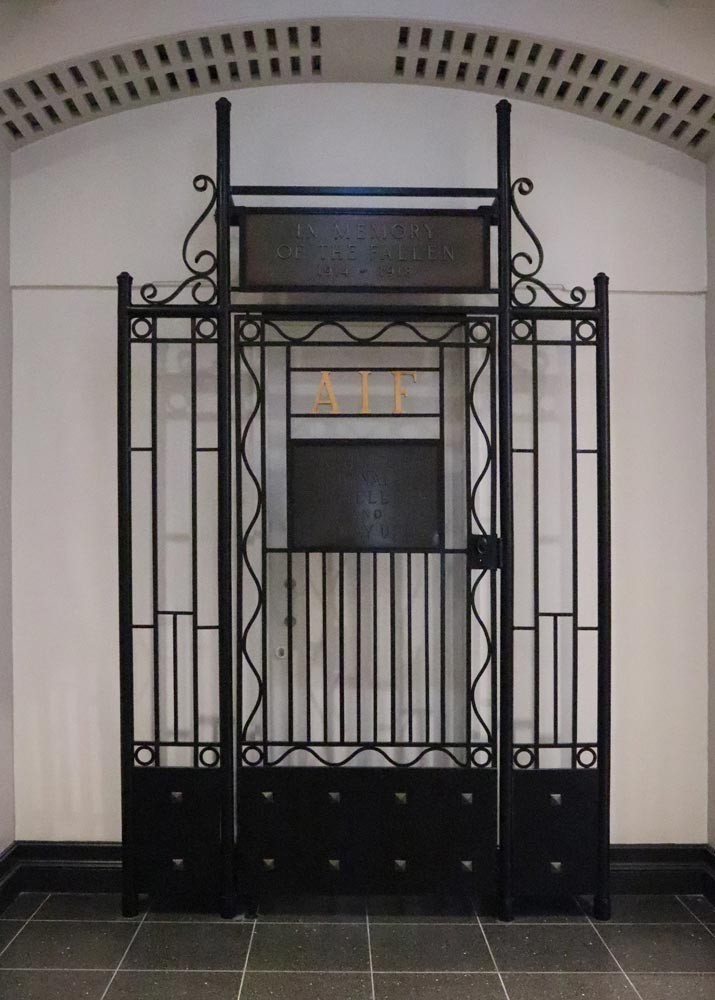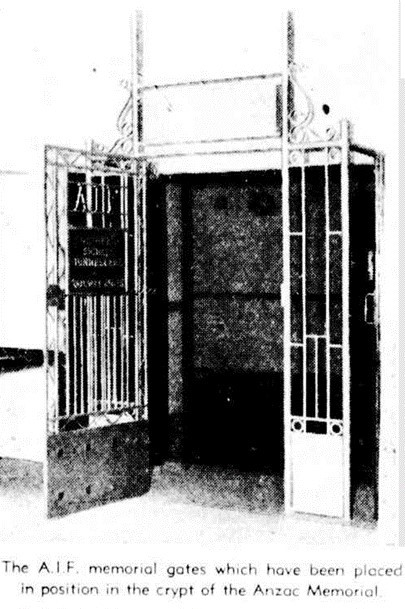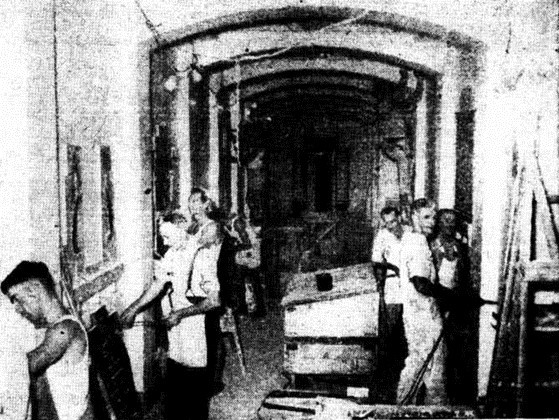The Story of the Engineers, Signals, Tunnellers and Railway Units Memorial Gate
By Anzac Square Memorial Galleries | 6 October 2021
Perhaps one of the most unique memorials in Anzac Square is the Engineers, Signals, Tunnellers and Railway Units Gate. Whilst it currently stands at the end of the WWI Crypt, it is very clear that it has not always been in this spot. This post traces the story of the gate and how it came to its current resting place.

The Engineers, Signals, Tunnellers and Railway Units Gate where it currently stands in the WWI Gallery. From the Anzac Square website.
As its name suggests, the gate was proposed and funded by the Engineers, Signals, Tunnellers and Railway Units Association. This group was formed in 1929 by a handful of ex-A.I.F. engineers who, after meeting at an Anzac Day parade, wanted to gather on a more regular basis.
By 1933 the association was well established and raised the idea of installing a plaque in the Anzac Square crypts. A memorial to Australian engineers had already been dedicated in 1930 at Kitchener Chapel, London (the namesake, Lord Kitchener, was considered the greatest engineer in the British army). However, given their proportionally large losses - 1331 engineers killed in action, 4910 casualties and 76 prisoners of war - the Association greatly supported erecting a plaque closer to home.
In 1936, arrangements for the memorial were well underway. By this stage, instead of a plaque, the association planned to install two memorial gates. This was motivated by discussions with the Queensland A.I.F. Units Council, which had been planning to replace the silky oak doors in Anzac Square with iron gates, one at the entrance of each crypt. The Engineers Association proposed to fund these gates, which they believed would serve as a fitting tribute to their fallen.
Evidently, at some stage, the plan to install two gates was also changed. Later articles only mention one gate, which was installed at the entrance of the right-hand crypt (the current post-1945 Gallery). It is clear, however, that the Engineers Association dedicated a lot of time and effort to its production. A great number of individuals were involved, including Captain C. E. Plant, who drew up the original design; Mr James Stewart, who produced the inscription; and Buzzacott Ltd, the Queensland company charged with manufacturing the gate itself. Colonel D. E. Evans, Mr J. Nicholson and Mr Monty Bloom (the patron, president and secretary of the association) oversaw the fundraising. A Courier Mail article from the 21st of April 1937 lists some of the association members who donated.
The gate was unveiled on Anzac Day in 1937. Association members gathered in Albert Square at 8.50am and marched to Anzac Square at 9.00am. Lieutenant-Colonel Grant led the parade, which consisted of a guard, two officers and 40 men from militia units. They were preceded by the Brisbane Scottish band. Upon arriving at the entrance to the Crypt, the men gathered in fours along the subway where the ceremony commenced. An opening address was given by Colonel Evans and Governor Sir Leslie Wilson officially opened the gate at 9.30am. Reverend Norman Millar performed the dedication and Bugler Sergeant P. W. Higgins played the Last Post.

An image of the gate in place before it was unveiled on the 25 April 1937. Sourced from the Courier Mail.
The new memorial was well-received by all present. A Courier Mail article from the 26 April 1937 states that:
Welcoming his Excellency, Major N. O’Brien said that the gates, a combination of strength and beauty, were symbolical of the feats of valour of those whose memory had inspired the erection of the memorial.
The governor offered similar praise:
His Excellency, congratulating the units upon their initiative, said that when he arrived in Queensland the Anzac Square crypt was a cellar-like place that was a disgrace to Queensland. Thanks, however, to the endeavour and generosity of the City Council, the crypt was now a memorial chapel worthy of the units represented in it, and the gates added greatly to its beauty.
It can be assumed that the gate stood at the entrance of the current Post-1945 Gallery until at least 1952. In this year a new crypt - the current WWI crypt - was built and all memorial objects were moved into this space, including the Engineers gate.

Workers constructing the new memorial crypt in 1952. This became the current WWI Memorial Crypt. Sourced from The Telegraph (Brisbane).
Photographs indicate that, when the gate was originally moved, it was installed in the spot where it currently stands at the far end of the crypt (closest to the WWII Gallery). However, later images show it at the opposite end, just beyond the entrance.
Clearly, there is more to the story of the Engineers Gate. Whilst this post is the result of a preliminary search of newspaper articles, there is undoubtedly more to discover. In the meantime, the Anzac Square team encourages readers to come view this wonderful piece of history in person.
Readers might also be interested in the following digitised articles on Trove:
- War Memorial: Australian Engineers (The Telegraph (Brisbane), 2 August 1930 p.7)
- Improvements to Anzac Memorial Chamber (The Telegraph (Brisbane), 21 March 1936 p.10)
- A.I.F. Units Memorial Gate (The Telegraph (Brisbane), 12 May 1936 p.20)
- Anzac Memorial: Underground Room to be Altered (The Courier Mail, 19 June 1936 p.19)
- Memorial Gates (The Telegraph (Brisbane), 17 February 1937 p.8)
- Memorial Gates Fund (The Courier Mail, 21 April 1937 p.12)
- Engineers Memorial Gates: Official Opening This Morning (The Sunday Mail, 25 April 1937 p.7)
- Technical Units Memorial Gates (The Courier Mail, 26 April 1937 p.21)
- £4000 of ex-AIF Engineers (The Telegraph (Brisbane), 23 January 1946 p.5)
- Governor to open crypt on Sunday (The Telegraph (Brisbane), 15 April 1952 p.3)
More information
- Anzac Square Memorial Galleries - https://www.anzacsquare.qld.gov.au/
- Trove digitised newspapers - https://trove.nla.gov.au/search/advanced/category/newspapers
- Ask Us - /plan-my-visit/services/ask-us
Comments
Your email address will not be published.
We welcome relevant, respectful comments.